The abstracts from short talks and posters presented at Open Science Days are now published in a booklet available on zenodo (10.5281/zenodo.14621398).

It is still possible to sign up to attend the Open Science Community Lund start-up meeting!
The abstracts from short talks and posters presented at Open Science Days are now published in a booklet available on zenodo (10.5281/zenodo.14621398).

It is still possible to sign up to attend the Open Science Community Lund start-up meeting!
At the LU Open Science Days, the Open Science Community Lunds (OSCL) was launched. As part of the launch, we gathered ideas for fostering constructive actions on open science. These actions will be discussed further at the Open Science Community Lund start-up meeting on the 5th of February. Do you want to join the meeting and hear more about the community? Sign up here.
Here are all the actions collected from the participants, in no particular order.
Blue (Researchers and teachers)
Green (support staff)

SciLifeLab Data Centre and NBIS, in collaboration with SciLifeLab Lund, welcome you to join a 2-day event with presentations, workshops, & networking. SciLifeLab Data Management is a collaborative activity between SciLifeLab Data Centre and NBIS Data Management team. Together we support and collaborate with the Swedish life sciences research community and infrastructure. Our aims are to: maximize the value of life science data, highlight and disseminate information about Open Science, FAIR, and good RDM practices, offer services, tools, and support, and offer courses and training.
The roadshow will feature:
1) 11th Dec. Seminar “Overview of Research Data Management services and support available locally and from SciLifeLab”
15:30-16:30 (fika will be served from 15). Venue: Belfragesalen, BMC D15
Target group: PhD students, postdocs, researchers and infrastructure staff.
2) 12th Dec
FAIR Frukost. 9:00-10:00. Venue BMC:E11079 Dialogen. Target group: PhD students and postdocs
Workshop Part I: Data Management Plans. 10:00-12:00 . Venue BMC:E11079 Dialogen. Target group: PhD students, postdocs, researchers and infrastructure staff
Workshop Part II: Data submission to public repositories. 13:00-15:00. Venue BMC:E11073 Rådslaget. Target group: PhD students, postdocs, researchers and infrastructure staff
Registration deadline: December 9th
Event page: https://www.scilifelab.se/event/scilifelab-research-data-management-roadshow-in-lund/
Last week the second instalment of the LU Open Science Days took place at Palaestra. The conference committee was happy to welcome 150 participants from LU as well as both Swedish and international organizations and institutions. The theme for this year’s conference was Crossing boundaries with Open Science focusing on how Open Science can bridge boundaries, both within academia and in society at large.

In their welcoming speech, Pro-vice chancellor Per Mickwitz and chair of the programme committee Angeliki Adamaki introduced the organisers of the event, the LU Open Science Champions Group, and how Open Science principles can benefit not only individual researchers and academia but society at large. Per talked about how the current geopolitical insecurities has led to some people saying that we have already passed the peak of Open Science. The pro vice-chancellor said that “we need to speak up for Open Science”.
The welcome speech was followed by a session on broadening of merits and recognition of Open Science contributions in research. Keynote speaker Björn Hammarfelt, professor at the Swedish School of Library and Information Science, spoke about possible future scenarios for Open Science in regard to merits: openness can become a metric in itself, how researchers are assessed can be opened up and reformed, assessment procedures and indicators can become more open. Concluding, Hammarfelt stated the importance of keeping Open Science flexible and non-standardized, not only benefiting the already privileged few within research.
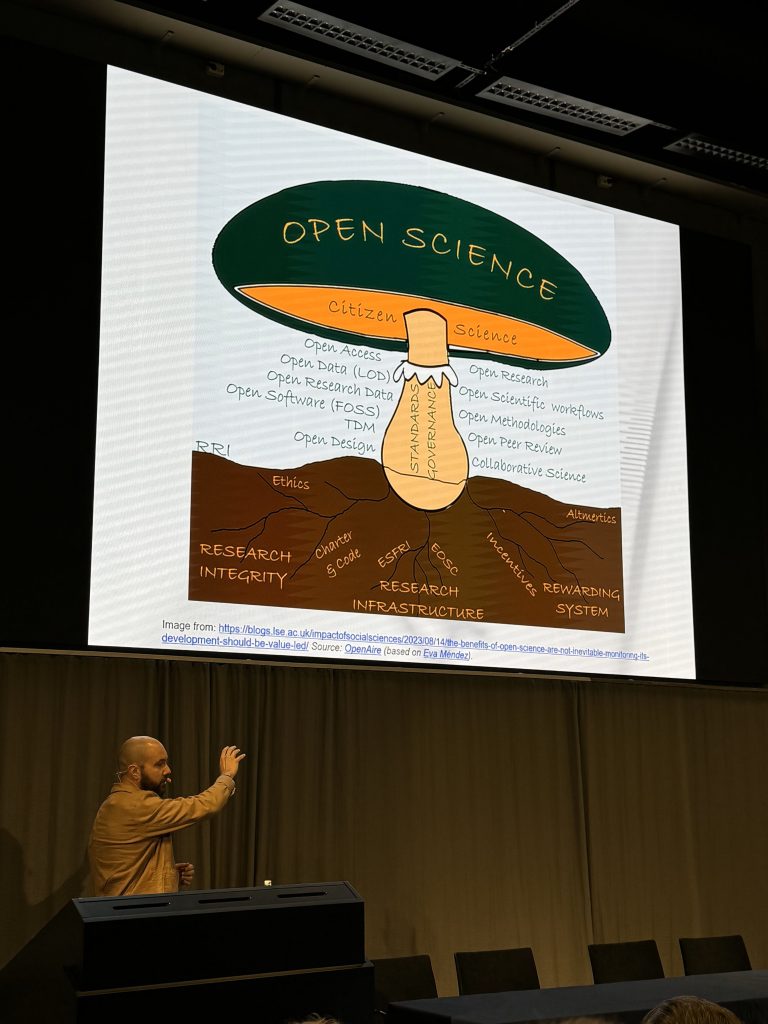
The following panel discussion with Jonathan Nästesjö, Alison Gerber, Johan Revstedt and Björn Hammarfelt led by Nicoló Dell’Unto continued on the same theme and the complexity of the notion of openness and reforming rewards and incentives. Among the things addressed was that changes are needed on both a university management level and community level.
In line with the aim of LU Open Science Days to be a platform for sharing ideas and experiences of practicing Open Science we invited six speakers to present their Open Science projects. Andrea Tarallo, National Research Council of Italy (CNR), Institute of Research on Terrestrial Ecosystems (IRET), presented the Italian data stewards community, established in 2023 as a bottom-up initiative, and how the community has evolved from a loose network into a more structured entity. Jane Fisher, AdvanSci, gave an introduction to the ReproducibiliTea initiative and the Lund-based journal club that explore challenges in reproducibility within biomedicine and the wider scientific landscape. Carlos Vélez, LUCSUS, talked about his research project concerning sustainable wildlife management in the Colombian Amazon region inspired by Participatory Action Research (PAR), practicing participatory research with two teams of local indigenous researchers. Lydia Bucher from the student organisation iGEM Lund, outlined their outreach activities such as workshops for high school and middle school students and social media engagement. Per Wilhelmsson, PKI Utveckling, presented Sjölabbet, a research-through-education initiative that promotes the use of the open source hardware OpenFlexure microscope (OFM) in educational settings. The microscope is used for aquatic environmental monitoring. Lastly, Massimiliano Novelli from ESS introduced ESS approach to FAIR data management and its integration with the PaNOSC (Photon and Neutron Open Science Cloud) data portal to support a collaborative and data-driven scientific ecosystem.
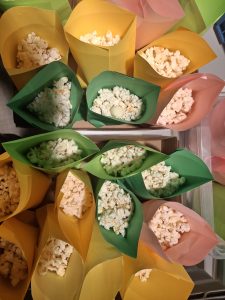
The last session of the day featured a film screening of the film Who stands up for Alvar. The film is based on research data from the research project “Moral stress and moral agency in Swedish eldercare”. The screening was followed by a discussion between the director Anna Maria Jóakimsdóttir Hutri and Sara Hultqvist, School of Social Work, about how art and research can be cross-fertilized and serve as a catalyst for social change. Jóakimsdóttir Hutri received the research data in the form of small stories and moral dilemmas that she in turn shaped into a script for the drama. Hultqvist and Jóakimsdóttir Hutri also talked about how the film created a space for all care workers, regardless of professional role or educational level, to have their voices heard.
During the poster mingle a diverse set of exhibitors displayed their Open Science projects and initiatives. Exhibitors included Carbon Ruins, a portable museum created by Narrating Climate Futures at LU, Vattenhallen Science Center, The Swedish National Data Service, Lund University Press, the LUCRIS administration and Skissernas Museum – Museum of Artistic Process and Public Art.
Keynote speaker on the second day, Mirjam Walpot from the International Network of Open Science & Scholarship Communities talked about the importance of communities in the transition to Open Science. The transition towards making Open Science the norm can be conceptualised via five interventions: infrastructure, user experience, communities, incentives and policy. Here, communities are a part of making Open Science normative and something that not only concerns a small number of early adopters but a majority of researchers. Communities can also be a way of influencing policy making and incentive structures. Mirjam Walpot is originally from the Netherlands, where the Open Science Community has been involved in the Netherlands National Program Open Science 2030.
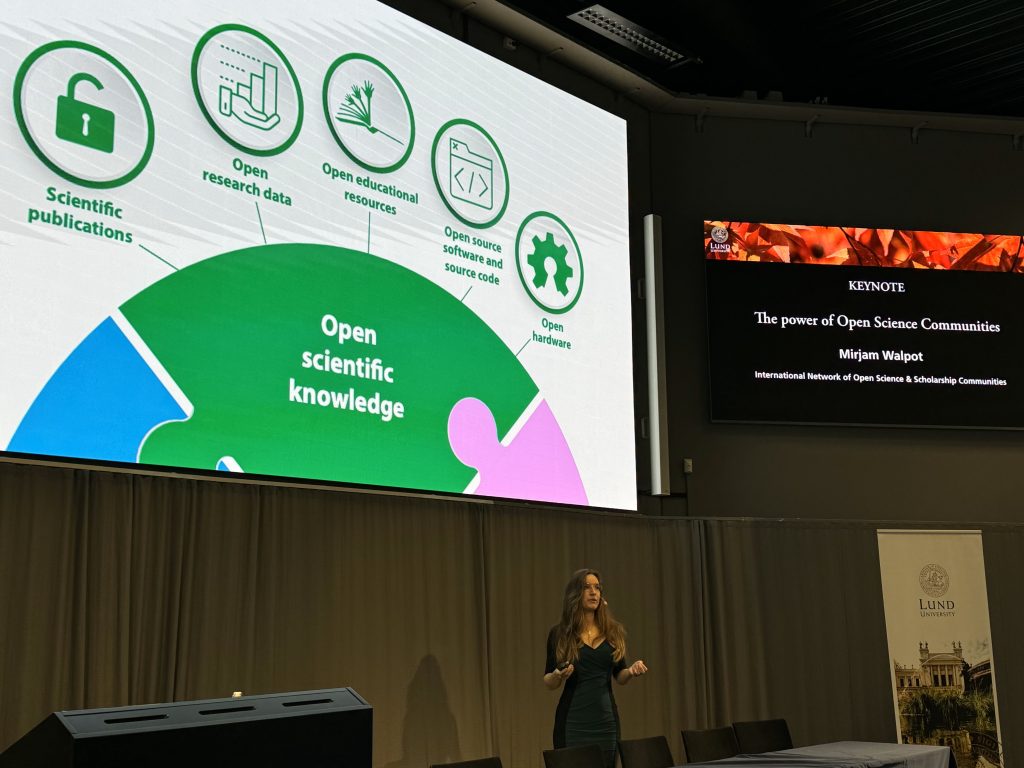
During the panel discussion on Open Science and the climate emergency Aitzkoa Lopez de Lapuente Portilla, Division of Hematology and Transfusion Medicine, talked about the role of researchers and universities in not reproducing unsustainable practices but being advocates for change. Researchers, by virtue of their expertise, connection to decision making, platforms and implicit authority, have the levers organise and take direct action for the climate. James White, Department of Technology and Society, talked about the environmental impact of the use of AI. AI tools are often presented as unproblematic from an environmental standpoint and the energy consumption needed to power these tools overlooked.
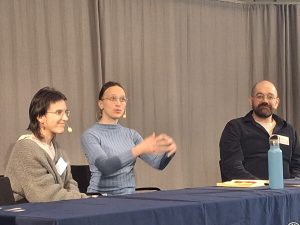
The last panel discussion concerned the geopolitical aspects of Open Science, focusing on East Asia. Hyejin Kim, Department of Economic History, outlined shifting patterns within international research collaboration. Focusing on collaboration rates of Chinese-based scholars, Kim showed the development of co-authorship with Chinese-based scholars and scholars from The United States as well as East and South-East Asia. Nicholas Loubere, Centre for East and South-East Asian Studies, talked about the dangers of Open Science being co-opted and redefined by authoritarian interests.
The conference closed with a community building session and the launch of Open Science Community Lund (OSCL). OSCL is a hub that connects researchers and employees at the university that believe in open science as means to increase inclusivity, quality, transparency and integrity in research. The community is a bottom-up initiative that aspires to facilitate the adoption of open science practices for the benefit of both research and society. OSCL welcomes members in all career stages and from all departments at the university with interest in any aspect of open science. You decide your level of engagement with the community and it range from organiser of events to supporter of the community’s work. If you want to be part of, or informed about the progress of the Open Science Community Lund, please sign up here.
Most slides from the conference are available in the programme blog post.
We would like to thank Lund University Press, who have kindly gifted us 11 printed copies of their Open Access books, that will be drawn by lot to a few lucky participants. Keep a look out in your mailboxes.
Thanks to all who attended and contributed to the LU Open Science Days 2024!
Open Science Days is approaching and here comes a brief teaser about the poster mingle and exhibition on the 19th of November. The exhibition will feature diverse things that are used to create and communicate science.
We are happy to announce that the portable museum Carbon Ruins, created by Narrating Climate Futures at LU will be displayed on during the mingle. Vattenhallen Science Center will display an activity they developed for children that allows them to dig for 3D-printed dinosaur fossils. The Research Data Office unit will bring a poster and present what support LU researchers can expect from them in the area of research data management. Jane Fisher from AdvanSci will introduce solutions for researchers in the biomedical sciences that aims at increasing transparency and research and the recently initiated ReproducibiliTea Open Science Journal Club. Per Wilhelmsson will display a microscope that is based on open hardware and used for aquatic environmental monitoring. A MOOC for high school science teachers organized by researchers from ESS and LU will also be presented and you will also meet researchers from the HOMEROS project that work with solutions for assessing hazards like earthquakes, floods and landslides. The Swedish National Data Service will join from Gothenburg and present present their upcoming national portal for research data, Researchdata.se, as well as their involvement in Skills4EOSC. Skissernas Museum – Museum of Artistic Process and Public Art will present their work with Object Based Learning – an inclusive and student-centered pedagogical method with an interdisciplinary approach. The LUCRIS administration will also be represented during the mingle to talk about making your research visible.
Join us for drinks and snacks on the 19th to enjoy this smorgasbord of examples of and support for open science. It is still possible to register!
Are you eager to shape the future of open science and be part of a growing movement at Lund University? Join us during the LU Open Science Days for interactive community-building sessions and become a founding force behind the new Open Science Community Lund (OSCL)!
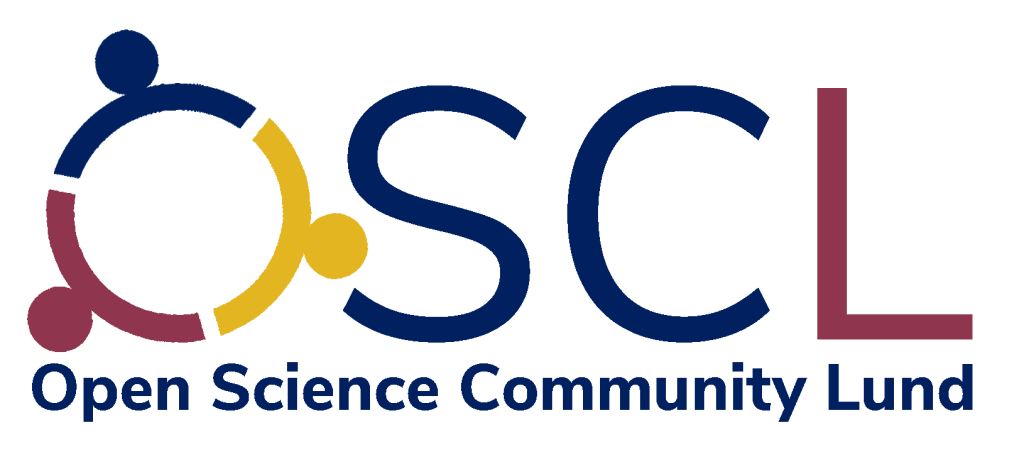
In the morning session on Day 2, we’ll dive into inspiring insights from the International Network of Open Science & Scholarship Communities (INOSC) to explore how researchers worldwide are fostering open science at local, national, and global levels. Together, we’ll brainstorm “micro-actions”—practical steps we can take individually or with peers to promote open science that don’t depend on formal structures.
Our final session of the mini-conference is where the magic of collaboration happens! Working in small, diverse groups, we’ll review the collected actions, refine them with fresh perspectives, and prioritize the most impactful ideas. An expert panel will offer guidance, share real-world experiences, and provide strategies to make these actions work in your unique context.
The event will close with the launch of the Open Science Community Lund (OSCL), a new initiative dedicated to supporting open science both at Lund University and beyond. This is your opportunity to connect, contribute, and be part of a network of Open Science advocates!
Whether you’re just starting with Open Science or are already deeply involved, these sessions are designed to inspire and equip you with practical ways to bring Open Science to life in your work and community. Join us, and let’s make science open, collaborative, and inclusive—together!
If you agree with the INOSC Guiding principles and Code of Conduct and want to be part of OSCL sign up here.
The LU Open Science Days aims to be a platform for sharing ideas and experiences of practicing Open Science. This year we wanted to facilitate this by inviting LU-affiliated researchers, PhD students, and research support staff, as well as non-LU contributors, to present their Open Science projects. The presentations will follow the conference theme “Crossing boundaries with Open Science”, illustrating how Open Science bridge boundaries, fosters collaboration, and create real-world impact.
After posting an open call for talks, we are happy to present four speakers for the session, representing a diverse set of organisations and Open Science approaches:
Andrea Tarallo, National Research Council of Italy (CNR), Institute of Research on Terrestrial Ecosystems (IRET) – Building the Italian data stewards community
Jane Fisher, Co-funder and managing research consultant at AdvanSci – Reproducibility and the ReproducibiliTea Initiative
Carlos Vélez, Doctoral student, LUCSUS – Exchanging Researcher Seats: Weaving Research with Indigenous Knowledges Systems for Forest-Fauna-Human management in the Colombian Amazon.
Lydia Bucher, iGEM Lund – Science activism, citizen science, and partnerships with society
Per Wilhelmsson, PKI Utveckling AB – Sjölabbet – Creating avenues for environmental monitoring
Massimiliano Novelli, Senior Data Curation Scientist, European Spallation Source (ESS) – Maximizing Scientific Output through Data FAIRness
Presentations will be held on the 19th of November. For more information, see the full program.
Perhaps you have been wondering: “How does Lund University’s infrastructures work with Open Science?” We sure have. First out to answer (tricky?) questions on the subject are national and European research infrastructures ACTRIS (Aerosols, Clouds and Trace Gases Research Infrastructure) and ICOS (Integrated Carbon Observation System), represented by Erik Swietlicki (Swedish national contact person for ACTRIS) and Jutta Holst (Swedish national contact person for ICOS).
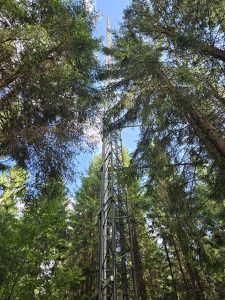
With ACTRIS focusing on short-lived climate-affecting air pollutions, and ICOS on persistent greenhouse gases, together they facilitate research on climate change, air quality and the exchange between terrestrial ecosystems and the atmosphere. In brief, this is done by the capturing of greenhouse gases, aerosol particles, meteorological and atmospheric chemical parameters followed by the generating and making available (raw/quality assured) data via ACTRIS Data portal and ICOS Carbon Portal, respectively. Adding to their affinity is the fact that their Lund University affiliated research stations are co-located deep in the lush Scanian forest (at Hyltemossa, close to Perstorp).
The ACTRIS and ICOS user base consists primarily of climate-, earth system- or air quality scientists and modelers who are highly dependent on reliable and diverse observations. Apart from scientific studies, data from ACTRIS and ICOS are also recurrently used by governmental authorities.
We were curious to know how the principles of Open Science and FAIR data are used in their field of operations, and how this modus operandi makes a difference for the researchers. Turns out, both research infrastructures are fully based on the concept of Open Science, and FAIR data principles are strictly adopted. ACTRIS and ICOS practice according to CC BY 4.0, meaning data can be used by anyone, free of charge and from anywhere in the world, with the only requirement being that users must indicate the origin of that data, i.e. data citation.
In a world increasingly challenged by climate change and pollution, the type of research that ACTRIS and ICOS facilitates is critically important, and much of the work currently done would not have been possible if the data had not been freely and easily available.
When researchers themselves visit the research stations aiming to do specialized measurements using their own equipment, they are explicitly encouraged to follow the principles of Open Science in publishing and making available their own data. In fact, Erik and Jutta lets us know that they are currently working on developing a system to help users with this in the future. The need for this kind of support is especially apparent when it comes to metadata (that describes what the data contains and where it is made available).
Both agree that Open Science is the new standard for all research data, and that data funded by taxes and of great interest to citizens must be made available in an effective way. However, much work remains to implement this principle.
On the topic of data citation, Erik and Jutta emphasize that this is simply a matter of good research practice and that data citation is fully comparable to the citation of other sources, e.g. peer-reviewed articles. They continue:
“Citing and acknowledging data from our infrastructures is also a way of showing appreciation to the people in the network, such as researchers, engineers and data managers, who produce and quality-assure our data and make it accessible and useful to all.”
That said, it is a bit of a challenge to see ACTRIS and ICOS data cited correctly, but they are working to make the rules clearer and raise awareness of the importance of data citation for the survival of research infrastructures.
Continuing the topic of challenges: to get users to even go through with making their data available in the first place sure poses one. Erik and Jutta explain that since researchers use their own funds, they are not guided by the same requirements as ACTRIS and ICOS to deliver data to online portals. Furthermore, ACTRIS and ICOS have no say in the “where and how” data should be shared, hence it’s not given that an externally funded researcher’s data will become linked to their data offer. According to Erik and Jutta, part of the solution is a systematic and joint solution for the management, storage and distribution of both metadata and data, free of charge and open to not just Lund University researchers but anyone regardless of academic affiliation, in Sweden and beyond.
To round off (and to provide some understanding on the cool applications of ACTRIS/ICOS data):
ACTRIS: Data from ACTRIS helps authorities across Europe to get a better understanding of the consequences of air pollution episodes, large-scale forest fires and volcanic eruptions. In other words, the sort of events that you really would want to keep track of.
ICOS: Following the explosion of the Nordstream gas pipeline in the Baltic Sea, methane gas levels became locally enhanced, and were registered by ICOS equipment (most apparently at Hyltemossa). These data have afterwards helped many different actors in Sweden and around the world to improve models on how gas spreads from a point source.
A sincere thanks to Erik and Jutta for sharing their facts and thoughts!
Websites:
ACTRIS SWEDEN https://www.actris.se/
ICOS SWEDEN https://www.icos-sweden.se/
On data citation:
ACTRIS and ICOS follow the Force 11 Joint Declaration of Citation Principles, which recognizes data as important and citable research products. Read more about these principles here.
Join the ICOS data citation campaign, primarily aimed at users but also scientific journals and reviewers of scientific papers. Spread the word!
Are you using Open Science to cross boundaries in your research or initiatives? Have you collaborated across disciplines, connected academia with society, or navigated Open Science in a rapidly changing geopolitical landscape?
The program committee of the LU Open Science Days 2024 invites LU-affiliated* researchers, PhD students, and research support staff to present their projects on November 19, 2024, either as a short talk or a poster. With this year’s theme, “Crossing Boundaries with Open Science,” we are seeking contributions that illustrate how Open Science bridges these boundaries, fosters collaboration, and creates real-world impact.
We welcome submissions on topics including, but not limited to:
Cross-disciplinary research and collaboration across fields.
Science activism, citizen science, and partnerships with society.
Geopolitical challenges addressed through Open Science.
Global collaborations between LU and external institutions.
Creative communication using Open Science practices.
How to Submit (please state your preference in your application):
Talks: Submit an abstract (200-400 words) by November 1st to monica.almqvist@bme.lth.se. Because of limited available time, selected talks will be informed promptly. All other contributions can be presented as posters or at booths.
Posters: Submit your abstract (200-400 words) by November 5th to alice.olsson@ub.lu.se. Any format goes.
Please mark your email “Open Science Talks and Posters”.
*Non-LU contributors are warmly encouraged to apply; a limited number of spots is available for exciting external contributions.
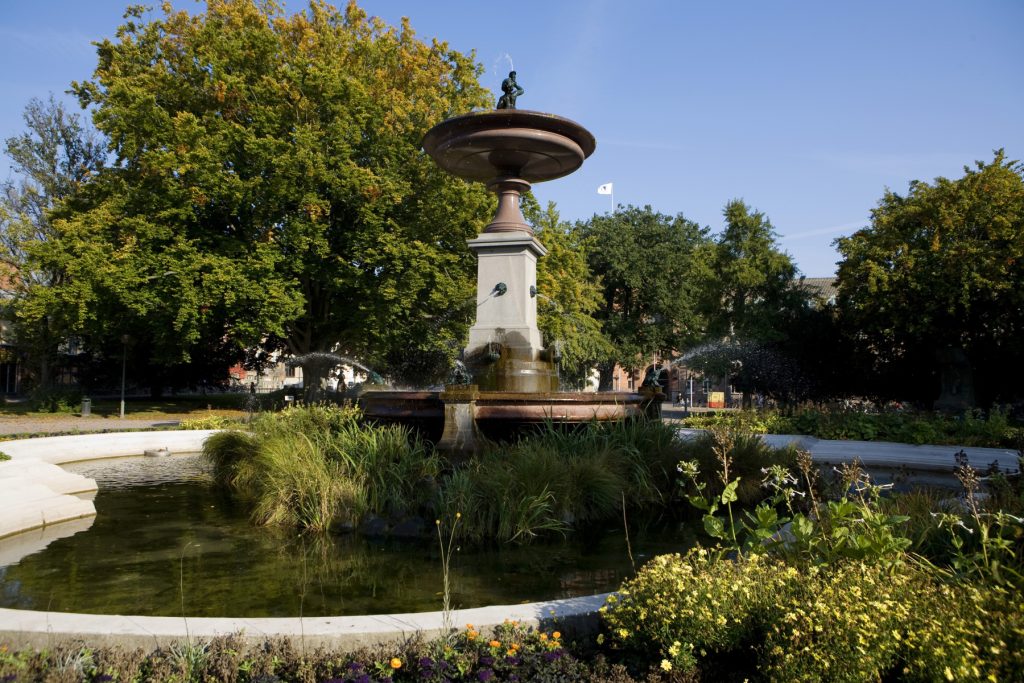
The Swedish Open Science Community held their yearly meeting and conference in Växjö this week. Angeliki, Sara and Karolina went there to learn more about the community and get to know its members. Talks and presentations addressed how to increase reproducibility and rigour in research and we also heard about SciLifeLab and Skills4eosc. Mirjam Walpot, that will hold keynote on LU Open Science Days, gave an inspiring lightning talk about the International Network of Open Science & Scholarship Communities. On the evening of the first day, we attended a live podcast with Nullius In Verba on the topic criticism on open science. When published I can really recommend you listen to it.
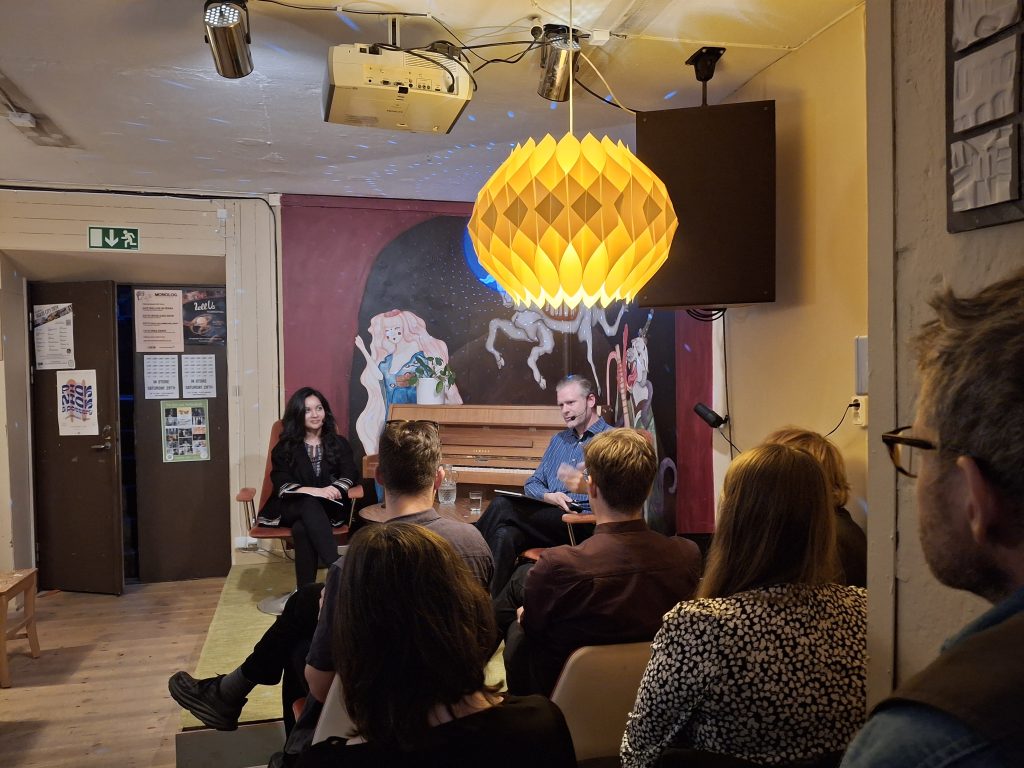
If you want to be part of the setting up an Open Science Community at LU please come to LU Open Science Days! You can of course join later if you like. The program for the days is continuously being updated with speaker.
Comments